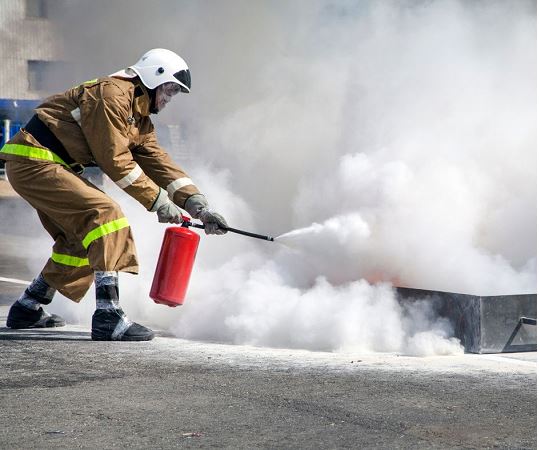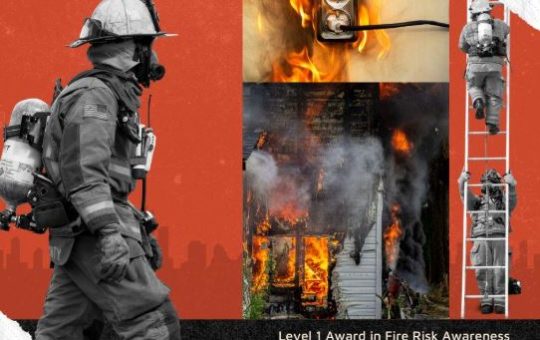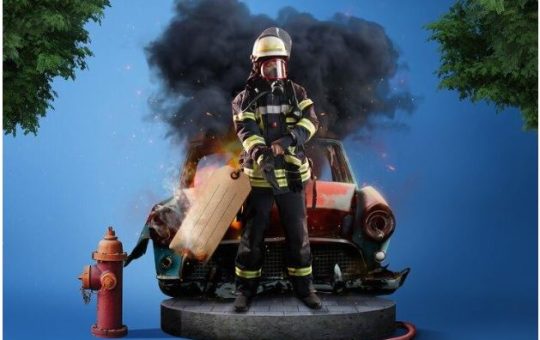
Fire Safety Level-1
Fire Safety Level 1 (Basic) Course
Course Overview The Fire Safety Level 1 Basic Course is designed to provide individuals with fundamental knowledge and skills to understand fire safety principles, identify fire hazards, and take appropriate measures to ensure workplace safety. This course is ideal for beginners, employees, and individuals who want to create a safer environment in homes, offices, or public places. Through a mix of theoretical and practical learning, participants will gain the confidence to prevent, respond to, and manage fire emergencies effectively.Benefits ⦁ Enhanced Awareness: Learn how to identify and mitigate fire risks in various settings. ⦁ Compliance: Meet legal requirements and industry standards for fire safety in workplaces. ⦁ Confidence Building: Gain the ability to act swiftly and responsibly during fire emergencies. ⦁ Career Foundation: Serve as an entry point for advanced fire safety training and certifications. ⦁ Practical Knowledge: Hands-on training to operate fire extinguishers and follow evacuation protocols.Learning Outcomes By the end of this course, participants will be able to: ⦁ Understand the basic principles of fire safety and prevention. ⦁ Identify fire hazards and assess fire risks in the workplace or home. ⦁ Recognize different classes of fire and suitable extinguishing methods. ⦁ Safely operate fire extinguishers and other fire suppression tools. ⦁ Develop and implement basic fire emergency procedures, including evacuation plans. ⦁ Comprehend legal responsibilities related to fire safety in the workplace. Career Progression Completing the Fire Safety Level 1 Basic Course opens doors to various career opportunities and further training: ⦁ Job Roles: ⦁ Fire Safety Assistant ⦁ Health and Safety Representative ⦁ Emergency Response Team Member ⦁ Advanced Training: ⦁ Fire Safety Level 2 (UK) ⦁ Risk Assessment Training ⦁ Fire Warden/Marshal Training ⦁ Occupational Health and Safety Certifications (IOSH, NEBOSH) ⦁ Industries: ⦁ Hospitality and Tourism ⦁ Manufacturing and Warehousing ⦁ Retail and Office Environments ⦁ Educational Institutions ⦁ Pathway to Specialized Careers: This course can act as a stepping stone for those interested in pursuing specialized roles, such as Fire Safety Manager, Health and Safety Officer, or Firefighter.Study Units
The Fire Safety Level 1 Basic Course is divided into the following key modules:
⦁ Introduction to Fire Safety
⦁ Importance of fire safety
⦁ Basic fire science (the fire triangle)
⦁ Fire Prevention and Risk Assessment
⦁ Common fire hazards
⦁ Strategies for minimizing fire risks
⦁ Fire Classification and Extinguishing Methods
⦁ Classes of fire (A, B, C, D, K)
⦁ Appropriate extinguishing agents for each class
⦁ Firefighting Equipment
⦁ Types of fire extinguishers and their uses
⦁ Maintenance and inspection of firefighting tools
⦁ Emergency Preparedness
⦁ Developing an evacuation plan
⦁ Roles and responsibilities during an emergency
⦁ Legal and Regulatory Framework
⦁ Overview of fire safety regulations and standards
⦁ Employer and employee responsibilities
Upon successful completion of this qualification, learners will be able to:
Understand Fire Safety Fundamentals: Explain the principles of fire science, including ignition, spread, and extinguishment.
Identify Common Fire Hazards: Recognize potential fire risks in workplace, domestic, and public settings.
Apply Basic Fire Prevention Measures: Demonstrate understanding of methods to prevent fire ignition and spread.
Classify Types of Fire: Differentiate between various fire classes (A, B, C, D, K) and select the correct extinguishing medium.
Operate Firefighting Equipment: Show basic competence in using fire extinguishers, alarms, and other suppression tools safely.
Respond to Fire Emergencies: Follow established fire emergency and evacuation procedures appropriately.
Understand Legal Responsibilities: Describe the duties of employers and employees under fire safety legislation.
Promote Fire Safety Awareness: Encourage safe behavior and fire prevention practices within the workplace or home environment.
Contribute to Emergency Preparedness: Support fire drills and assist in ensuring safe evacuation during emergencies.
The Fire Safety Level 1 (Basic) Course is designed for individuals seeking essential knowledge in fire prevention, detection, and emergency response. It is ideal for those with little or no prior experience in fire safety who wish to develop a foundational understanding of workplace and home fire risks. This course serves as an introduction for anyone responsible for basic fire awareness and safety within their environment.
It is particularly suitable for:
Employees and Staff Members across all sectors who require fundamental fire safety awareness.
New Recruits and Induction Trainees who must comply with workplace fire safety requirements.
Supervisors and Team Leaders needing a refresher on essential fire prevention and emergency procedures.
Homeowners and Domestic Carers who wish to improve household fire prevention awareness.
Retail, Office, and Hospitality Workers who interact with the public and must understand evacuation procedures.
Students or Interns entering industries where fire safety compliance is mandatory.
Individuals Preparing for Fire Safety Level 2 or Fire Warden Training as part of a career development pathway.
Our assessment process is designed to ensure every learner achieves the required level of knowledge, skills, and understanding outlined in each course unit.
Purpose of Assessment
Assessment helps measure how well a learner has met the learning outcomes. It ensures consistency, quality, and fairness across all learners.
What Learners Need to Do
Learners must provide clear evidence that shows they have met all the learning outcomes and assessment criteria for each unit. This evidence can take different forms depending on the course and type of learning.
Types of Acceptable Evidence
Assignments, reports, or projects
Worksheets or written tasks
Portfolios of practical work
Answers to oral or written questions
Test or exam papers
Understanding the Structure
Learning outcomes explain what learners should know, understand, or be able to do.
Assessment criteria set the standard learners must meet to achieve each learning outcome.
Assessment Guidelines
All assessment must be authentic, current, and relevant to the unit.
Evidence must match each assessment criterion clearly.
Plagiarism or copied work is not accepted.
All learners must complete assessments within the given timelines.
Where applicable, assessments may be reviewed or verified by internal or external quality assurers.
Full learning outcomes and assessment criteria for each qualification are available from page 8 of the course handbook.
Top Courses
Related Courses
Let's Get in touch
Deleting Course Review
Course Access
This course is password protected. To access it please enter your password below:



